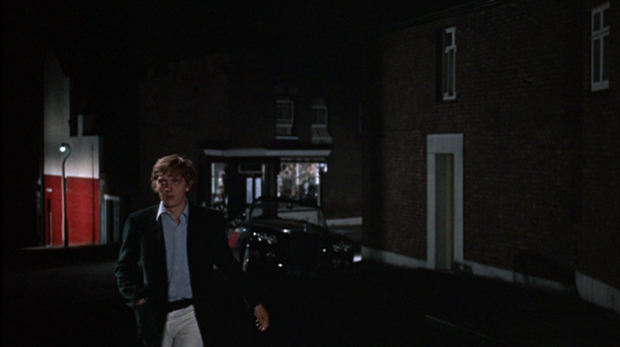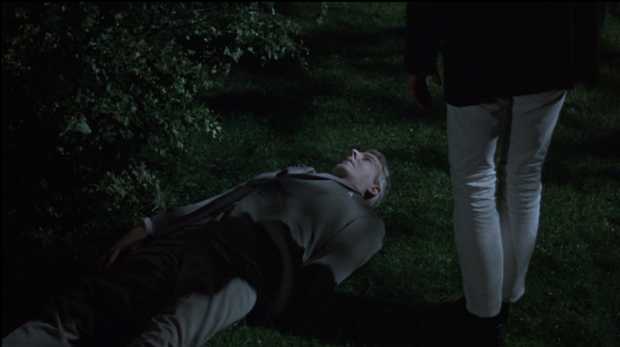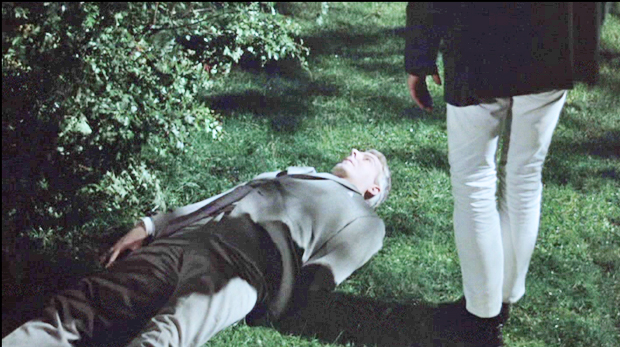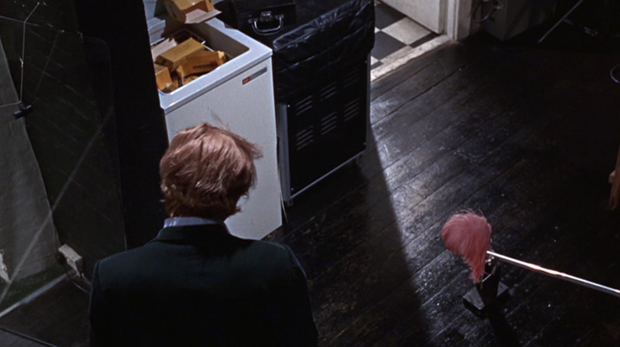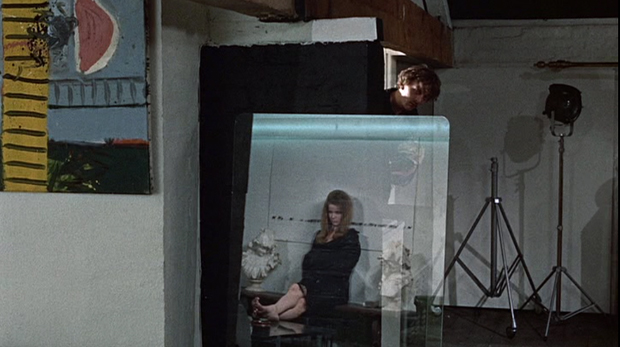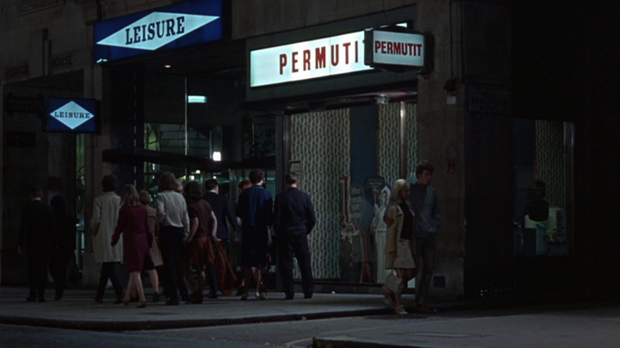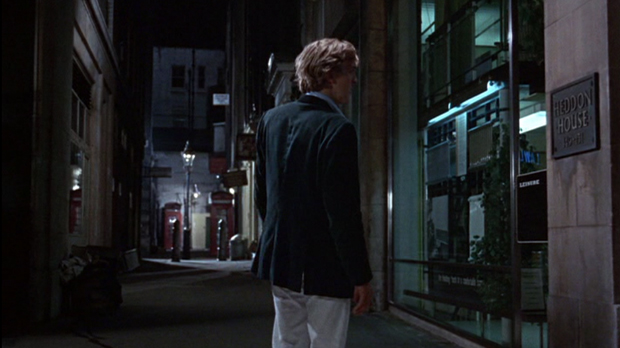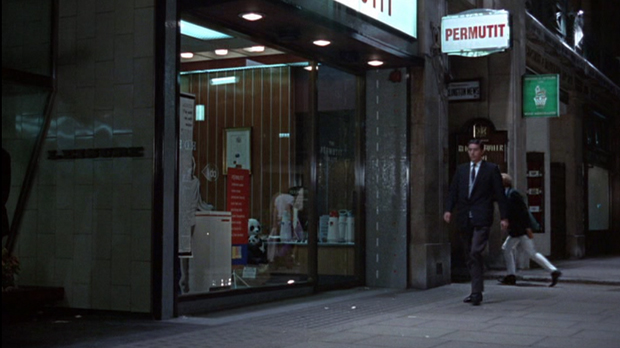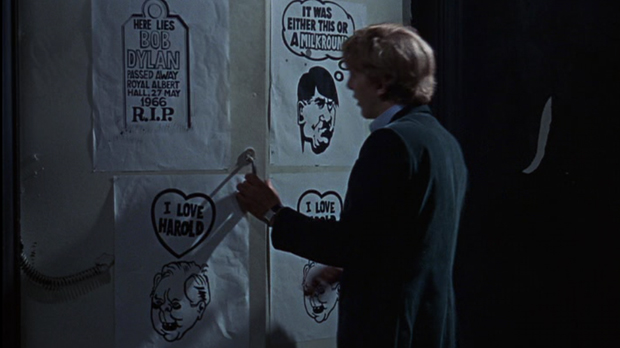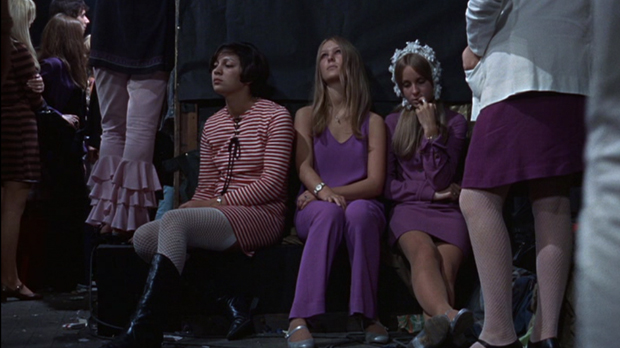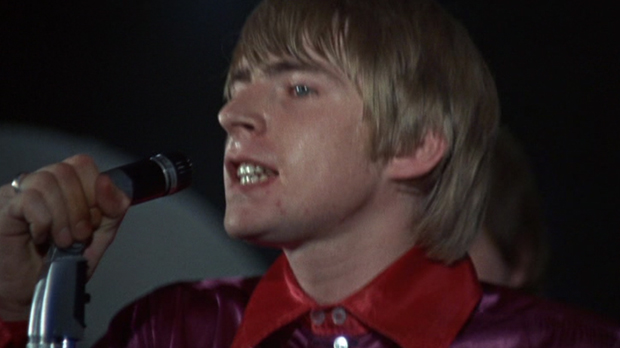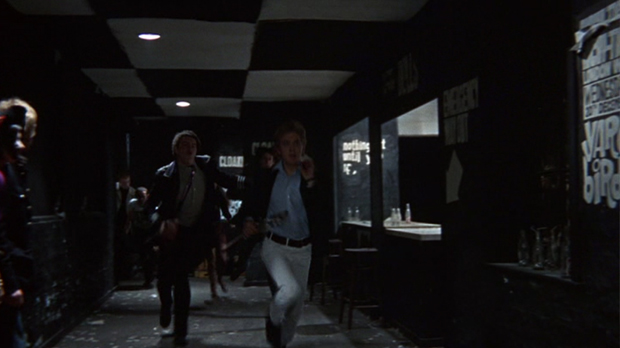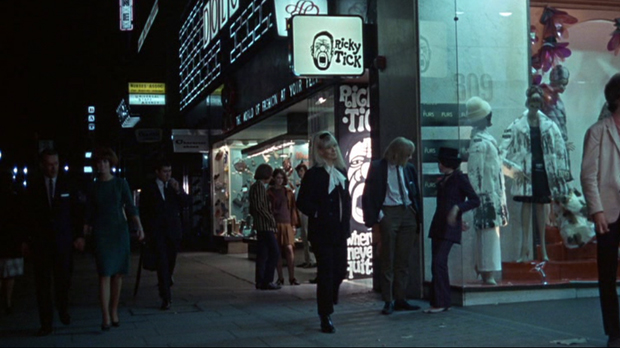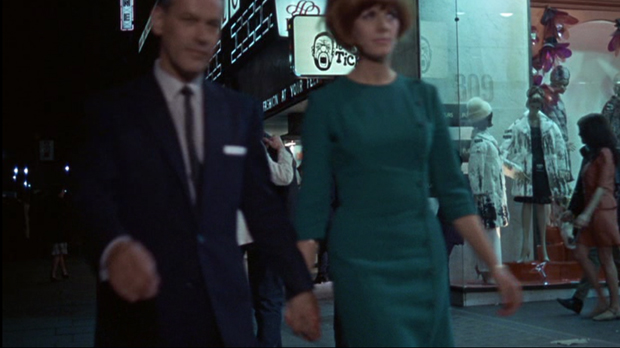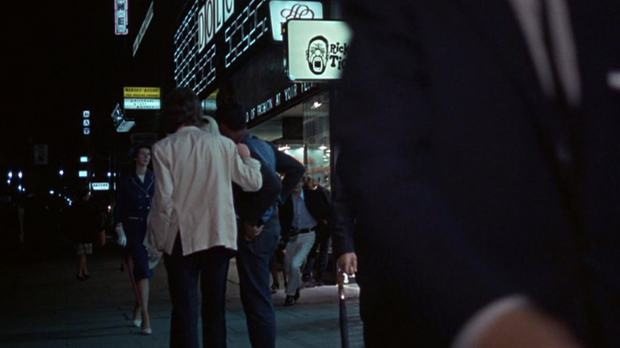MICHELANGEO ANTONIONI's BLOW-UP

Go to Table of Contents of the analysis. Antonioni's films are rife with themes, peculiarities and incongruities which largely go unnoticed due his deft care in handling them and the abundant and rich audio and visual textures in which he immerses us, but they are also responsible for the sense of mystery that defies a traditional expectation of resolutions, infusing Antonioni's films with enigmatic mythic purpose. And myth is never hampered by logic.
PART FOUR
TOC and Supplemental Posts | Part 1 | Part 2 | Part 3 | Part 4 | Part 5 | Films Home
LINKS TO SECTIONS OF THE ANALYSIS ON THIS PAGE:
Thomas Returns to the Park
Were You Looking for Something Just Now?
Transformation
THOMAS RETURNS TO THE PARK
417 LS of the antique shop at night, a red wall beyond.
It is night. Thomas drives around a corner past the antique shop and parks, beyond seen a red wall that serves as a transition point back to the green grass, that red wall recalling the prior transition when he had driven down the street past the repeating Pride & Clarke red buildings on his first trip to the shop, the red buses he had passed when leaving, and other red transitions besides. He gets out of the car and proceeds to the park, the red wall reflected on the door of his car.
418 LS of Thomas from within the park, beyond one of the gateway trees, entering. We see a glimpse of a red neon sign up in the right hand corner. He passes under another neon sign, one we had seen in the morning when he was driving to the antique store.
419 LS Thomas mounting the stairs to the upper level of the park. Brushing his left shoulder with his right hand, he progresses onto the green, seeming a little tenative, reluctant.
420 LS of the dark upper level of the park.
We hear the breeze through the trees. Thomas enters the frame from the left, now running.
421 LS of Thomas from the front, looking about the green.
He pauses as he walks, slowing to a halt, then continues.
422 CU of Thomas from behind.
As he walks there now enters the right of the screen the dead man behind the tree, his face illuminated with the neon light that we had initially seen. Thomas stops, then approaches.
423 MS of Thomas coming round the tree.
He kneels beside the dead man who exists, he isn't a figment of Thomas' imagination. A ghastly gray figure, he lies with wide open eyes, staring unblinking into nothingness. Thomas touches his cheek.
424 MCU of Thomas from below.
425 MCU of the face of the dead man.
As with Mark in Zabriskie Point, as with David in The Passenger, we see no blood, no trauma, no bullet wound. The dead man almost resembles a pale mannequin in his repose.
426 MS from behind Thomas kneeling next to the dead man.
Thomas slowly rises.
And I have always wondered where in the heck is the lower part of the man's left arm? Where is it? One may say the dead man is lying on it, but I swear it looks like his left arm is just gone below the elbow, just not present. For what effect is this posing? Observe how the shadow of Thomas' leg connects with where the dead man's arm seems to disappear. One could imagine, via this shadow, the dead man is hanging onto Thomas' leg. If it's imagined this is a fanciful bit of thinking, remember that Antonioni much earlier opened the door to it with Bill's observation on his paintings that begin as messes, but then he finds something to hang onto, such as a leg, followed by Thomas' curiosity in and offer to purchase the painting that could be seen as expressive of film grain and thus Thomas' later dilemma of sorting out the truth in his blow-ups as he dug deeper into the grain.
A highlighted version of the image of the dead man shows it seems that the shadow area between Thomas' foot and the dead man's arm has been artificially darkened.
A leg to hang onto, the painter had said, and the rest sorts itself out.
427 CU Thomas from behind.
Thomas standing, does he hear something? The crackle of a twig breaking under someone's foot? It sounds as if it is, followed perhaps by a footstep. But then the tree rustles with the breeze making us uncertain.
Is someone watching? If Thomas is the shooter as the cameraman, would it be himself? Is it the click of his own camera that he hears? No, the sound is distinctly different from the earlier snaps of Thomas' shutter in the park, but there is still a connection to be made.
For the first time, curiously, Thomas is without his camera.
He has become a part of the picture, entered its world.
All one really needs to know is that the protagonist has been in great confusion. He had seemed entirely confident and full of himself at film's beginning. Then he came upon a mystery of death, finding in the quiet, still paradise of the park. Thomas had told Ron that his book, full of violent images, should end with an image from the park, peaceful. Instead, he has uncovered a murder.
If he does not act rationally, calling the police, it is because the film is not speaking to the purely rational, logical mind.
Thomas, eyes questioning, turns around.
428 MS of Thomas standing beside the dead man, looking over his shoulder to the rear of the park. The camera follows Thomas as he first walks then runs away.
WERE YOU LOOKING FOR SOMETHING JUST NOW?
429 LS of Thomas entering his first floor studio.
On the first floor level where he'd earlier been photographing the "birds", where the propeller was delivered, he stands for a moment in the quiet.
He steps forward and gently taps the propeller with an outstretched foot.
Then Thomas turns and we see his reflection in a large sheet of metal, perhaps aluminum, as he looks up toward the second floor. We expect him to go upstairs. Instead, he exits.
430 MS of Thomas from the courtyard, exiting his studio. He crosses the courtyard to the home of the painter.
431 MCU Thomas from the side, approaching the artist's open door and entering. We hear soft jazz playing.
432 From inside Bill's home, Thomas entering the hall. Thomas looks toward the studio, then pauses and looks back toward Bill's bedroom.
433 MS from inside Bill's bedroom, Thomas through the venetian blind slats of the doors. He looks briefly bewildered, then his expression becoming more ambiguous.
Thomas approaches and looks in.
This is similar to the shot when Patricia approached him with a beer. Similar to his looking out the venetian blinds at the window and seeing the stalker.
434 Patricia and Bill making love on their bed, from Thomas' POV.
The sheets are white but the blanket is a bright red.
435 MCU of Thomas watching.
436 CU of Patricia opening her eyes and seeing Thomas.
437 As with 433, Thomsa gazing on. He pulls back and starts to walk off.
438 MS of Patricia and Bill on the bed, Patricia mouthing no, gesturing for Thomas to not move.
439 CU of Patricia.
440 CU Thomas stepping back to where he was.
441 CU Patricia.
Her eyes on Thomas, she smiles gently, ecstatic, a certain peculiar sharing quality in this expression she extends Thomas, even of communion.
442 Thomas gazes on, both reluctant and mesmerized. He then glances behind himself.
443 CU of potatoes and bread on the counter.
444 CU Thomas as he reluctantly turns his head slightly back, but not completely.
Photography is sometimes talked about as a voyeuristic profession. Bill's earlier behavior had certainly been voyeuristic with his secretly taking photos within the doss house, camouflaged as another similarly homeless person, and his pursuit of Jane and the man, hiding even in trees and behind a fence so as not to be observed. Now, however, confronted with Patricia's gaze, he wants nothing more than to leave, discomfited. When I first saw this on a small television screen, many years ago (in black and white), the impression I'd gotten was that Patricia wanted Thomas to remain where he was for fear of interrupting Bill. My reasoning had been that it was perhaps a while since they'd made love, and just as Bill was feeling uncertain about what he was doing with his current painting, perhaps he had been impotent or disinterested. Instead, Patricia beckons Thomas to remain where he is as she wants him to watch. Whether she is making love then to Bill or Thomas or them both is uncertain, the movie full of ambiguities. Their first scene together had suggested a mutual interest which they both avoided and satisfied with friendly gestures.
445 CU Patricia, her eyes continually on him.
446 CU Thomas glancing down at her and beyond.
447 CU of a radio, presumably the source of the music, a triangular marble ashtray. Cigarettes (No. 6 brand.)
This is an image that is repeated in Zabriskie Point. At the end, right before the final "blow up" (for there are many beforehand), we have a shot of a table on the balcony of the land developer's house, and on the table is a magazine and an ashtray with two still burning cigarettes. Then the camera pans over to a second table to show a radio.
448 CU The camera's eye, and perhaps that of Thomas' now pans over the red blanket over the feet of the couple, the foot of the bed, to the multi-colored splatters of paint on the floor which are first spread thickly then thin out.
The floor recalls the painter's canvas lying on the floor in the next room, the one that Thomas had wanted to purchase, which the painter hadn't begun to sort out yet.
449 MS of Patricia and Bill from within the bedroom.
Just as Bill seems to have finished, Thomas now leaves and when he shuts the door the painter hears and raises his head, only conscious that Thomas was there once he's left. We never see Bill's face through this scene.
As we never see Bill's face in this scene, we also never see his face in a scene with Patricia. Earlier, when Thomas had visited, he had first spoken with Bill. Then Bill had conveniently disappeared, staying in the studio, when Patricia entered, her leg first appearing by the painting (something to hang onto), then she taking a beer from the refrigerator for Thomas and massaging his head. Bill was out of the scene, never speaking, not reappearing. And in this scene again we in a way feel that once again we've not seen them together.
450 MS of the purple crumpled backdrop in Thomas' studio, where he and the two girls had earlier had sex.
Thomas returns to his home and studio. First we see the crumpled purple backdrop, and following after the love scene with Patricia, there may be a sense of emptiness, of the vacuity of his love life, sex with models and hopeful models for whom he seems to have nothing but contempt and whom he abuses.
He pauses as he ascends the stairs.
451 MCU Thomas before the plastic sheeting on the window.
452 From behind Thomas, his studio, all the photos of the park gone.
Thomas had just been there a few mintues before. He had looked at the propeller (without which he couldn't live), then rather than go upstairs he had gone over to the artist's. Perhaps the thief or thieves were upstairs in his studio even then, as he stood downstairs. Though he tried to leave immediately when he saw Bill and Patricia making love, she had stopped him. Had that delay saved his life? Had he returned to his studio only a few moments earlier, would he have run into the thief or thieves?
453 MS from behind Thomas of the empty walls.
The tops of the photos had been fastened to the walls and beams, but the bottoms had been weighted with clamps hanging on lines. All that remains are the lines strung around the room with the clamps dangling from them.
454 MCU Thomas from behind.
455 Thomas' face reflected in the coffee table.
He glimpses his face in the glass of the coffee table. One notes reflected also some metal hardware fixed to an above beam that seems to form an arrow pointing screen right. Compare this "arrow" with the same metal hardware as it was glimpsed toward the beginning of the film, just before Thomas began his photo shoot with Verushka.

It was not yet an arrow there.
This stands to be compared with the placement of the magnifying glass on the table.
456 CU 3/4 view of Thomas from behind. He approaches his work bench.
457 MS view of Thomas' work bench now in disarray.
He rushes off screen right to the walkway to his darkroom (we have been viewing him through the window, we realize, as he passes behind the plastic sheeting that is still up and then exits onto the walkway).
458 MS Purple dark room door, partially open. Thomas enters. It has been ransacked and it appears that all his film rolls have been stolen. There were a number of them in here earlier on the counter. He exits and enters the green door of the next dark room.
459 MS second dark room. It too has been ransacked.
460 LS overhead from upper level of Thomas coming down the walkway and entering. He passes under a beam and the camera.
He looks at a pink ostrich feather that remains hanging on the end of a pole.
Following the "arrow" of the pink ostrich feather, Thomas discovers a photo that has slipped between a white case for storing film and a black case or appliance. Here between black and white, negative and positive, one of the photos has slipped, hidden away. It is the extreme blow up of the corpse, not discernible at all really to anyone but Thomas who went to the park and witnessed the dead man.
The lone bird feather signals the presence of this one photo. Augery. Signs. Through the course of the film, it seems he's been trained to read them. To pay attention. To submit to being led rather than forcing his way. Or to be in dialogue.
Compare the image of Thomas sensing where the photo lies with the shot in which he is reflected in the coffee table. With both there are the black and white fields side by side, and in both there is what may be described as a line functioning as an arrow which Thomas eventually follows, whereas at the film's beginning Thomas was always going opposite the direction that arrows pointed.
If we go all the way back to when we saw Thomas first entering his studio at the beginning of the film, we see the reflection of one of the busts positioned over where Thomas finds the photo.
It was on the head of this bust, where the cases meet, that Thomas had placed the match of his cigarette/joint when speaking with Jane. That same bust is the one that looked to match up with the headless statue at the antique store.
We had briefly glimpsed the propeller that will be purchased when Thomas was told the owner was out and Thomas had asked if he was expecting him. Later, Thomas purchasing the propeller, I had noted the dramatic display to the camera of black and white fabric as Thomas moved things so they could get the propeller out. The bust of the older man is observable behind the owner of the shop up until the moment Thomas lifts the chair, the chair then concealing it and the scene.
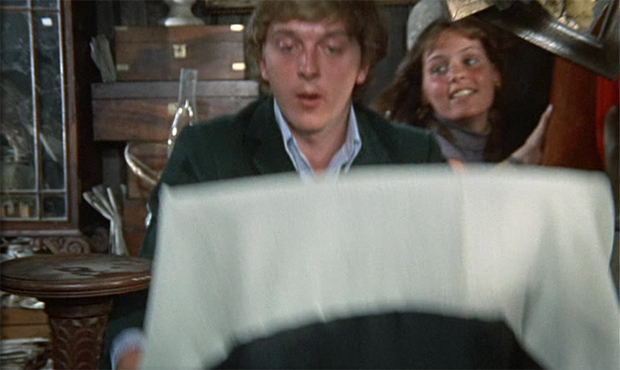
The bust of the elder man that was next the propeller in the shop can be thought of as prefiguring the photo showing the bust of the dead man by the tree, which Thomas finds between the black and white cases, pulls out and examines on the floor.
The white case will figure again shortly.
461 MCU Thomas crouching on the floor beside the photo.
462 MCU of Thomas from the side, the lounge area beyond. He hears a noise, someone coming up the stairs, and hides near the door to the kitchen.
463 LS of Patricia coming up the stairs. She is dressed all in red, red shoes, a red hand bag, and a dress of open red crochet lined in a flesh-colored fabric which gives the illusion of one being able to see through it to her nude body.
PATRICIA: Were you looking for something just now?
Well, just now in his studio Thomas was looking for the photos which had been stolen away. But she is referring to when Thomas had come down to their home after returning from the park. While he was being robbed.
One remembers that Thomas had earlier said he would sneak down one night and steal away the painting Bill was working on, which Bill had told Thomas not to even ask about yet. So, what happens while Thomas is down at Bill's, but the photos are stolen from his apartment. All but the most abstract one.
There had also been the impression that Thomas' expression of his desire for the painting, and carrying it off one night, might have been an expression of his desire for Patricia.
464 MCU Thomas beside the pane of glass.
THOMAS: No.
PATRICIA (off screen): Oh.
THOMAS (stepping toward her): Do you ever think of leaving him?
PATRICIA (with a half smile, looking toward the camera rather than Thomas): No, I don't think so.
Before continuing, I want to take a brief look at the choice of red here. Why that open red crochet dress? But, if one remembers, I mentioned that a bright red blanket had been covering Bill and Patricia as they made love. And though they were covered, they were also exposed, in a sense. Now, Patricia shows up all in bright red, the only person in the film to wear all red, and the red dress is an open red crochet with a nude lining.
I am reminded of how Thomas had said some people are politicians and some photographers. I think of the red capes that bull fighters swing in their dance with the sacrificial bull, the swinging of the cape seducing the bull into closer and closer passes, the red being to hide the color of blood.
Regardless of the meaning of the red, it has been used over and over, in particular as a transition color to the green of the park.
465 LS of Thomas and Patricia standing near the gray sofa and coffee table.
THOMAS: I saw a man killed this morning.
PATRICIA: Where?
THOMAS: Shot. In some sort of park.
Thomas removes from the crossbeam the remaining tattered edge of one of the stolen photos.
466 MCU Patricia.
PATRICIA: Are you sure?
THOMAS (entering the frame from the right): He's still there.
PATRICIA: Who was he?
467 MCU Thomas from behind Patricia.
THOMAS: Someone.
468 MCU from the front, Thomas and Patricia.
Peculiarly, Patricia smiles. Maybe she smiles because Bill had said in the end it all "adds up", and here the "who" equals "someone" or sum one.
Probably not but it's fun to note.
PATRICIA: How did it happen?
THOMAS: I don't know. I didn't see.
First he had said he had seen it, now he says he hadn't. Patricia looks at him, wondering. You didn't see it, she says in a voice that seems less a question than a statement.
PATRICIA: You didn't see.
THOMAS: No.
PATRICIA: Shouldn't you call the police?
Thomas doesn't answer though he slightly shakes his head yes. Instead he nods to the photo on the floor.
THOMAS: That's the body.
469 MCU of the photo on the floor from behind Patricia.
She stoops and picks it up. She examines it, dubious.
She perhaps doesn't see in it what Thomas sees. But unless one had seen the physical body, then it would be difficult to accept this is the photo of a corpse.
PATRICIA: Looks like one of Bill's paintings.
THOMAS: Yes.
PATRICIA (setting the photo down, after a pause, examining the line hanging from the wall): Will you help me?
470 MCU Thomas from behind Patricia.
PATRICIA: I don't know what to do.
Thomas looks side to side, not knowing what to say.
471 MCU Patricia with the area of the lounge with the camel photo beyond.
Thomas enters frame right.
THOMAS: What is it?
472 MCU Patricia with Thomas beyond. Instead of answering, Patricia wanders several steps away.
PATRICIA: I wonder why they shot him?
473 MCU Thomas.
474 MCU Patricia.
475 MS Thomas from behind Patricia, he leaning against the wall beside the white and black cases where he found the photo.
THOMAS: I didn't ask.
476 MCU of Patricia as she turns and leaves. On the way out she stops, looks back at Thomas, smiles. She exits down the stairs.
477 LS of Thomas from near the same perspective we had in a shot after Jane left, Thomas standing near where the photo was found between the black and white cases, the pink ostrich feather between them, highlighting.
478 MCU of Thomas having turned to the lounge. After standing and thinking a moment, he lunges for the phone.
THOMAS: Hello, Ron? Oh, hello, love. Is Ron there? No, I just wanted to take him somewhere. Where is he? Okay, I'll fetch him there. Bye-bye, love.
Thomas turns and exits down the stairs.
TRANSFORMATION
479 The camera comes up in a MS-LS from behind Thomas in his car now, driving, and stops in front of it as he pulls over and parks. He has seen, before a store named PERMUTIT, Jane window shopping.
480 MCU of Thomas looking back toward Jane, a ROBINSON & CLEAVER sign for a shop seen beyond him, across the street.
481 LS of Jane before PERMUTIT.
482 MCU of Thomas watching, turning to get of the car.
483 LS again of Jane.
She turns around. Does she see Thomas? Others approach and Jane disappears, as if melting into one of the passing women, legs merging. Event merging with another event, her person merging with another. One wonders if PERMUTIT has something to do with permutation, meaning a complete change; a transformation.
484 LS Thomas exits his car, PERMUTIT in the background.
485 MCU of Thomas approaching the shop. He runs past the shop, passing a man who is dressed as he is but instead wearing a red shirt.To screen left of PERMUTIT is the shop Leisure. Thomas first looks behind a wall here, thinking perhaps Jane had hidden herself there. But she's not to be found.
Note, however, the case that Jane was looking at in the PERMUTIT window. It is nearly identical to the case as was back at Thomas' studio, standing beside the black case, between which two Thomas had unearthed the photo of the dead man.
The man in an outfit very similar to Thomas' passes. The same white pants. Black belt. Blue jacket. Instead of Thomas' light blue and white checked shirt, however, he wears a red shirt. The man walks from screen right to screen left. And now Thomas goes to screen left to look down the alley to screen left of Leisure. Toward the end of the alley we see a street lamp brightly shining and two red telephone booths.
For some reason Thomas backtracks, he goes now instead to the alley at screen right of PERMUTIT, a woman in purple pants the same color as the backdrop at the studio passing by. From the position of the camera, the alley can scarcely be seen. As Thomas enters the alley, over which a green sign hangs, it almost seems as if he slips into a narrow, nearly imperceptible crack in the facades of the buildings.
I have already attempted to establish that Thomas' studio becomes also the park. Here, with the appearance of a very similar white case (beside which is seated a stuffed adult panda holding a baby panda) we are returned to his studio, to the white case resting beside the black case there, between which he'd found the photo of the dead man.
Note that also seen in the shop windows of PERMUTIT appear to be several coffee dispensers? I recall that Thomas had earlier asked the two girls, wannabe models, if "between them" they could make a cup of coffee.
486 MS Thomas, going down a dark alley, is now slipping himself into a between space. At the alley's rear is a sign with white lettering on red reading KEEP CLEAR. Hearing music, he turns left and races up stairs and in through a door past another sign reading KEEP CLEAR, entering a nightclub, The Ricky Tick, which is painted all black and white, just as his studio is predominately painted black and white.
487 MS of Thomas passing down an empty black hall lined with black and white posters.
He passes through another inner door on which there is a sign that reads "Here lies Bob Dylan, RIP." The date on the sign is 17 May 1966. Here is also a sign "I love Harold" which probably refers to the British politician, Harold Wilson.
If Thomas has slipped between the cracks where the photo of the dead man was found in his studio ("That's the body," he had said to Patricia), the image of the "Rest in Peace" tombstone is a salient one.
488 Thomas enters a large room crowded with people listening to a band.
It's the Yardbirds. They are on stage singing and the audience all watches them stark still, expressionless as mannequins. Thomas presses through them to the front of the stage.
489 LS of the band, Thomas pressing through to the stage.
490 Shot of the passive faces of the crowd.
491 Another shot of the passive faces of the crowd, this time from the side, as Thomas continues pressing through, looking for Jane. No one moves, no one looks at him.
492 The stage again and the band. We see Thomas in the crowd, continuing to look for Jane.
493 MCU The band.
494 MCU The singer.
495 CU The band.
496 MS Thomas at the rear of the club.
Only two people dance. A tall woman and a black man. Their movements, especially those of the woman, seem unrelated to the music, out of time with it And just to the side of them, beside a white door, stands an isolated man in white pants like Thomas', a black belt like Thomas', black shoes, blond hair cut like Thomas', but wearing a black or dark blue shirt. As Thomas passes him, as if on cue, the man raises a cigarette to his mouth and takes a drag, Thomas progressing on past the dancing couple.
It is a replay of the scene at Thomas' studio in which he was instructing Jane on listening to the music, on how to smoke, telling her to go against the beat when she was nodding her head out of sync with the music, telling her to go slow.
497 LS Thomas from behind as he passes the dancing couple.
498 MS of more faces of the audience, all impassive. Thomas passes a man wearing a red coat.
499 MS Thomas continuing to screen left. He passes in front of a group of impassive blonds, one in turquoise, and another impassive black man.
500 MS Thomas passes a woman with a bonnet on her head, sucking her finger, reminding of all the previous finger and hand to mouth gestures in the movie and perhaps associating them with this infantile appearance.
Thomas having passed by, the woman removes her finger from her mouth and rests her chin on her fist.
501 MCU the band on stage dealing with a crackling speaker and feedback.
502 MS the guitarist.
503 The crowd from the left of the stage, the guitarist in the foreground. He bangs on the amp/speaker.
504 Thomas in the crowd.
505 The guitarist banging again on the speaker.
506 The guitarist from onstage, behind the drums. A man in a lavender shirt and dark jacket steps out of the crowd and up to assist. He works with the VOX amp, pulling plugs.
507 Shot from the front of the stage of the man assisting and the guitarist who bangs the speaker again with his guitar.
508 MS Jeff Beck throwing his guitar to the ground. He breaks off the neck and stomps on the body.
OFF SCREEN VOICE: Give them a song again.
509 From behind Beck, he stomping the guitar.
510 The band.
Pan right to the singer, Keith Relf. With his blond hair, he reminds of Thomas. And his perspiration. He brings to mind Thomas’ exertions with the models, attempting to drag smiles out of them, seeking response.
Jeff Beck has made a rather passionless but purposeful display of blowing up as he bangs the amp then smashes his guitar and breaks the neck off of it. The crowd goes Dionysian wild as the Yardbird throws this piece of the guitar into the audience, fighting for the neck. Thomas grabs the neck and goes running off with it, nearly colliding with a couple as he flees down the black and white hall out the front entrance of the club.
511 The band.
512 Jeff Beck picks up the pieces of the guitar. He stomps on the guitar, separating the neck from the body. He throws the neck into the audience.
513 View of the audience from behind the band as the neck is hurled from the stage. The audience, formerly absolutely still, goes wild, fighting with each other to get the neck, pushing people into the stage.
514 MS the audience fighting, women pushed into the stage, screaming.
515 LS of the audience from the stage.
516 CU the singer.
517 MCU within the audience as they fight. Thomas has grasped the guitar neck. He fights his way out of the crowd.
518 The crowd pursues Thomas as he flees to the door.
519 LS from the hall as Thomas runs into it and toward the camera.
520 LS Thomas running down another hall
In a sense, he has entered here the black and white world of the blown-up photos.
Just as Jane had slipped between the cracks, disappearing, just as Thomas had also slipped between the cracks, entering the alley to the nightclub as a man had passed, partly obscuring him, so does Thomas emerge from the black and white world of the club in the same manner, a passing couple obscuring his exit. And who is strolling past but a woman in a blue suit with white piping, white shoes and a red umbrella, who had also numbered among the individuals standing around Jane when she had disappeared before Permutit. She now also wears a checkered hat and carries a white coat. Point is made of her, the camera on her not only as she is walking past as Thomas slips from between the cracks onto the sidewalk, but returns to focus on her as she markedly glances at Thomas.
521 The Street. As individuals pass the camera, Thomas exits from the club, but his exit is not caught by the camera. He's only seen after he emerges. Just as Jane had disappeared, Thomas appears in the same manner.
522 Thomas falls back against a storefront window.
523 Thomas tosses the guitar neck on the street.
No one else follows Thomas out of the club. He's the only one to exit from between the cracks. Once outside the club, having emerged on another street, Thomas looks at the broken guitar neck as if it is useless and tosses it on the ground, behind him in the storefront a mannequin in a purple dress observed.
524 MS Thomas running off Three people had congregated just before Thomas ran out. A blond woman, a black man, and a white man in a light suit coat. The man in the light suit coat picks up the neck and quickly discards it as useless. The guitar neck, which had incited such a furor in the club, becomes meaningless trash when out of context.
Though I believe the broken guitar neck may refer to the bust of the dead man seen in the blown up photos, an allusion to the sacred, sacrificial and phallic nature of the instrument seems pretty obvious, the audience suddenly animated by a sort of blood lust, but exterior specific context the article of adoration becomes ordinary and everyday, a simple broken guitar neck. And so it is too with Thomas' transformative experience which, at least physically, has only left him with a token that no one else can decipher, in which no one will see the same material as he does, its meaning lost upon others. It becomes a useless artifact even to him outside the club.
Another thing to note. While the "Ricky Tick" was a real club, the interior was filmed on a stage duplicate of the club while the exteriors had nothing to do with the club's actual location. Thomas seems to enter at about 156 Regent St., located near a Burlington News sign at the Heddon House. I read the Ricky Tick club exterior, where he exits, is at a place now called the "100 club" which is at 100 Oxford St. In the movie he exits next a shop full of mannequins in the windows, furs advertised, and the address for the shop is viewed in one of the windows as 309.
One will recollect that Thomas' house number is 39. When he has slipped between the cracks into the Ricky Tick club, he has entered, as it were, "0", nothing, a place located in his own home at the 39 address.
The filming of his home was actually at about 77 Pottery Lane W11 in London, not 39. So, the 39 and the 309 are meaningful.
We've also here the OM which was introduced with the revelers when Thomas made his donation (graffiti on a wall as OMM of OHM) and I elaborated a little on when writing on the propellor.
The sanskirt for OM is:

Here is Thomas' address.
The 309 address out of which Thomas appears can be seen as Antonioni combining the OM with the 39. He's playing with shapes here, the 3 being Omega being also a part of the shape of OM. I write more on this in the last part of my analysis on The Passenger showing how Antonioni carries the motif through the three films. So read that for a fuller story on it because I'm not writing it out twice.
A Googlemap to the Heddon House where Thomas entered an alley that led to the "Ricky Tick".
A Googlemap link to 77 Pottery Lane.
View Larger Map
Approx 5900 words or 12 single-spaced pages. A 45 minute read at 130 wpm..
Next: Part Five
Blow-up TOC
Link to the main TOC page for all the analyses

